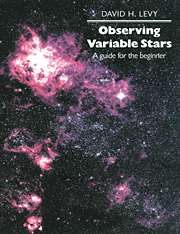Book contents
- Front Matter
- Contents
- Foreword
- Opening thoughts
- Acknowledgments
- Part 1 Getting to know the sky
- Part 2 Getting to know the variables
- 5 Meeting the family
- 6 Getting started with Cepheids
- 7 Algol, the demon of autumn
- 8 How to estimate a variable
- 9 Names and records
- 10 Observing hints
- 11 Stately and wonderful
- 12 Stars of challenge
- 13 Bright, easy, and interesting
- 14 Betelgeuse: easy and hard
- 15 Not too regular
- 16 Nova? What Nova?
- 17 Supernovae
- 18 Three stars for all seasons
- 19 A nova in reverse?
- 20 RU Lupi?
- 21 Orion, the star factory
- 22 Other variable things
- 23 The Sun
- Part 3 Suggested variables for observation throughout the year
- Part 4 A miscellany
- Index
16 - Nova? What Nova?
Published online by Cambridge University Press: 22 September 2009
- Front Matter
- Contents
- Foreword
- Opening thoughts
- Acknowledgments
- Part 1 Getting to know the sky
- Part 2 Getting to know the variables
- 5 Meeting the family
- 6 Getting started with Cepheids
- 7 Algol, the demon of autumn
- 8 How to estimate a variable
- 9 Names and records
- 10 Observing hints
- 11 Stately and wonderful
- 12 Stars of challenge
- 13 Bright, easy, and interesting
- 14 Betelgeuse: easy and hard
- 15 Not too regular
- 16 Nova? What Nova?
- 17 Supernovae
- 18 Three stars for all seasons
- 19 A nova in reverse?
- 20 RU Lupi?
- 21 Orion, the star factory
- 22 Other variable things
- 23 The Sun
- Part 3 Suggested variables for observation throughout the year
- Part 4 A miscellany
- Index
Summary
The afternoon summer storm has just passed and the sky is clearing rapidly. It's a weekend evening and you decide to set up the telescope. By the time the Sun has set, your telescope is assembled and you are ready for a night with the stars. What do you do first? While the telescope is adjusting to nighttime temperatures, check out the sky. Is it just as you left it last time? A good way to begin any night of observing is to review the familiar constellations and asterisms. Slowly and methodically check each star down to 2nd or 3rd magnitude. In all likelihood, all is well, but you never know. An erupting star, a nova, might be out there waiting to be noticed as a “star out of place.” A nova is not, as its Latin name implies, a new star. It is really an old star system that is exploding. In the case of an ordinary nova it is a binary system that goes into outburst as it blows off some of its atmosphere, or as a supernova, it spectacularly blows a large fraction of its mass over space.
A nova in Cygnus
Novae, though more frequent and less spectacular, are awesome in their own right. In August 1975, when I was returning with friends from an early dinner, I looked up, quite by habit, and saw what I assumed to be a slow moving satellite just north of Deneb.
- Type
- Chapter
- Information
- Observing Variable StarsA Guide for the Beginner, pp. 67 - 73Publisher: Cambridge University PressPrint publication year: 1989

